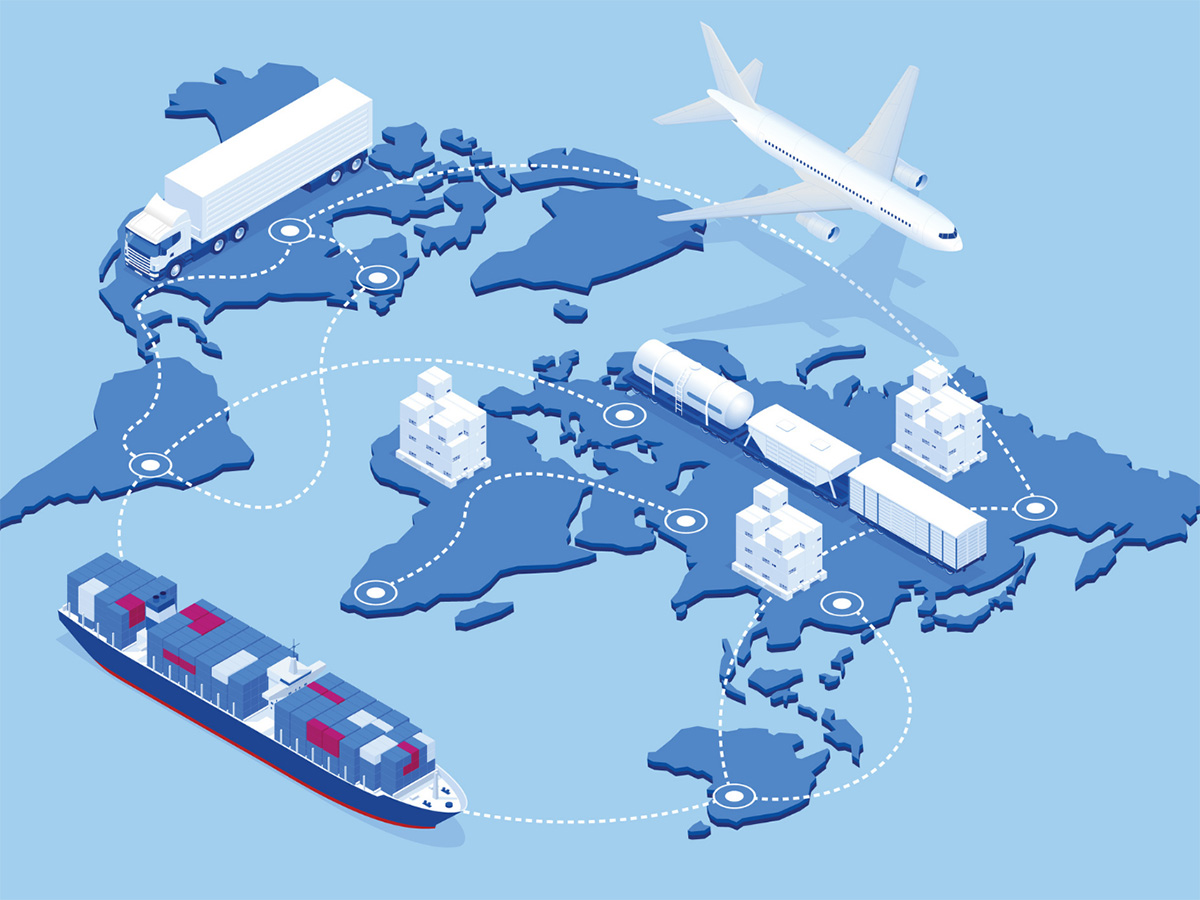

Finance
What Are Supply Chain Risks?
Published: October 19, 2023
Learn about the finance-related supply chain risks that can impact your business and how to mitigate them. Stay ahead of potential disruptions for smoother operations.
(Many of the links in this article redirect to a specific reviewed product. Your purchase of these products through affiliate links helps to generate commission for LiveWell, at no extra cost. Learn more)
Table of Contents
Introduction
In today’s globalized and interconnected world, supply chains play a critical role in the success of businesses across various industries. A supply chain encompasses all the activities and processes involved in the production, distribution, and delivery of goods and services to the end consumer. However, these complex networks are vulnerable to a wide range of risks that can disrupt operations, lead to financial losses, and damage a company’s reputation.
Supply chain risks refer to the potential disruptions and uncertainties that can impact the smooth flow of goods and services along the supply chain. These risks can arise from both internal and external factors, including operational inefficiencies, natural disasters, political instability, economic fluctuations, and even cyber threats.
Managing supply chain risks is crucial for businesses to ensure continuity, minimize disruptions, and maintain customer satisfaction. By anticipating and proactively addressing these risks, companies can better protect their operations, reputation, and bottom line.
This article aims to provide a comprehensive overview of supply chain risks, their importance, and strategies to effectively mitigate them. By understanding and mitigating these risks, businesses can enhance their resilience, maintain a competitive edge, and build stronger relationships with their suppliers and customers.
Definition of Supply Chain Risks
Supply chain risks are defined as the potential disruptions or uncertainties that can occur within a company’s supply chain, which can have adverse effects on the flow of goods and services, as well as the overall business operations. These risks can arise from various internal and external factors and can have significant financial, operational, and reputational impacts on a company.
Supply chain risks can be categorized into different types, including operational risks, financial risks, demand risks, supplier risks, and external risks. Operational risks refer to the risks associated with internal processes, such as production delays, equipment failures, or quality control issues. Financial risks pertain to disruptions in financial transactions and cash flows, such as currency fluctuations or payment defaults. Demand risks involve uncertainties related to changes in customer demand and market dynamics, such as shifting consumer preferences or sudden changes in demand patterns.
Supplier risks entail the risks associated with the company’s suppliers, such as supplier bankruptcies, quality issues, or inadequate capacity to meet demand. External risks, on the other hand, stem from factors beyond a company’s control, such as natural disasters, geopolitical events, regulatory changes, or global economic fluctuations.
It is important to note that supply chain risks are not limited to a single company or industry; they can affect organizations of all sizes and across various sectors. Moreover, supply chain risks are interconnected, meaning that a disruption in one area of the supply chain can have a domino effect on other parts of the network, impacting multiple stakeholders.
Managing supply chain risks involves identifying potential risks, assessing their potential impact, and implementing strategies to mitigate or minimize their occurrence. This proactive approach enables companies to enhance their operational efficiency, reduce costs, and ensure business continuity, even in the face of unforeseen events.
Importance of Managing Supply Chain Risks
Managing supply chain risks is crucial for businesses to ensure the smooth and uninterrupted flow of goods and services, mitigate potential disruptions, and protect their financial stability and reputation. Here are several reasons why managing supply chain risks is of utmost importance:
- Business continuity: By effectively managing supply chain risks, companies can minimize disruptions and avoid costly production delays or shutdowns. This ensures that they can meet customer demands, maintain a steady revenue stream, and safeguard their market position.
- Cost reduction: Supply chain risks can lead to increased costs, such as expedited shipping fees, stockouts, or quality issues that result in rework or product recalls. By proactively managing these risks, businesses can reduce unnecessary costs and optimize their supply chain operations.
- Reputation protection: A supply chain disruption can negatively impact a company’s reputation and erode customer trust. Effective risk management strategies help companies maintain consistent product quality, timely deliveries, and reliable customer service, fostering positive brand perception and customer loyalty.
- Value chain optimization: Managing supply chain risks involves identifying areas of improvement and implementing measures to enhance efficiency and resiliency. This can lead to a more streamlined and optimized value chain, enabling companies to gain a competitive advantage in the market.
- Collaborative relationships: By actively managing supply chain risks, companies can build stronger relationships with their suppliers and customers. Collaborative risk management efforts foster better communication, trust, and transparency, creating a mutually beneficial environment where all parties work together to address potential risks.
In today’s volatile and uncertain business landscape, proactive supply chain risk management has become a critical competitive advantage. It enables companies to navigate unforeseen challenges, adapt to changing market conditions, and maintain operational resilience. By investing in risk management strategies and tools, businesses can safeguard their supply chains, protect their bottom line, and ensure long-term success.
Types of Supply Chain Risks
Supply chain risks can stem from various internal and external factors and can have a significant impact on a company’s operations, financials, and overall performance. Understanding the different types of supply chain risks is key to effectively managing and mitigating them. Here are some of the main types of supply chain risks:
- Operational Risks: These risks are associated with internal processes and activities within a company’s supply chain. They can include production delays, machinery breakdowns, inventory management issues, inadequate quality control, or labor disputes. Operational risks can disrupt the smooth flow of goods and services, leading to supply chain inefficiencies and financial losses.
- Financial Risks: Financial risks encompass disruptions that impact a company’s financial transactions and stability within the supply chain. Examples of financial risks include currency fluctuations, credit or payment defaults, economic recessions, inflation, or price volatility. These risks can lead to increased costs, interrupted cash flow, or financial uncertainty within the supply chain.
- Demand Risks: Demand risks involve uncertainties related to changes in customer demand and market dynamics. These risks can stem from shifting consumer preferences, evolving market trends, or sudden changes in demand patterns. Failure to accurately forecast and respond to demand risks can result in excess inventory, stockouts, lost sales, or inefficient production planning.
- Supplier Risks: These risks are associated with the performance and reliability of a company’s suppliers. Supplier risks include supplier bankruptcies, disruptions in the supply of raw materials or components, quality issues, or inadequate capacity to meet demand. Dependency on a single supplier or a limited supplier base can amplify the impact of supplier risks.
- External Risks: External risks are beyond a company’s control and arise from external factors such as natural disasters, geopolitical events, regulatory changes, or global economic fluctuations. Examples of external risks include earthquakes, hurricanes, political instability, trade wars, or sudden policy changes. These risks can have far-reaching consequences on the supply chain, disrupting logistics, causing supply shortages, or creating legal and compliance challenges.
It is important for businesses to assess and understand the specific types of risks that are most relevant to their supply chain. This enables them to develop tailored risk management strategies and implement appropriate measures to reduce vulnerabilities, enhance resilience, and ensure continuity in their supply chain operations.
Internal Supply Chain Risks
Internal supply chain risks refer to the potential disruptions and uncertainties that arise from within a company’s supply chain operations. These risks can originate from various factors, including inefficient processes, inadequate infrastructure, poor inventory management, or internal communication breakdowns. Understanding and addressing these internal risks is essential for optimizing supply chain performance and minimizing potential disruptions. Here are some common examples of internal supply chain risks:
- Operational Inefficiencies: Inefficient processes can lead to delays, bottlenecks, or errors within the supply chain, impacting the timely movement of goods and services. These inefficiencies can stem from complex supply chain structures, lack of automation, inadequate training, or ineffective coordination among different departments or stakeholders.
- Poor Inventory Management: Inadequate inventory management practices can result in stockouts or excess inventory. Insufficient forecasting, inaccurate demand planning, or unreliable inventory tracking systems can lead to imbalances between supply and demand, affecting customer satisfaction and increasing costs for storing excess inventory or rushing to fulfill orders.
- Lack of Supplier Relationship Management: Failure to establish and maintain strong relationships with suppliers can lead to risks such as inadequate supply, delivery delays, or poor product quality. Lack of communication, failure to monitor supplier performance, or over-reliance on a limited supplier base can increase vulnerability to supply disruptions and affect the overall supply chain efficiency.
- Quality Control Issues: Inconsistent product quality or frequent defects can lead to disruptions in the supply chain. Quality control issues may arise from inadequate quality assurance processes, insufficient testing, or ineffective supplier quality management. These risks can result in product recalls, customer dissatisfaction, and damage to the company’s reputation.
- Poor Communication and Information Sharing: Ineffective communication and information sharing among different stakeholders within the supply chain can create misunderstandings, delays, or inefficiencies. Lack of real-time visibility, inadequate collaboration tools, or miscommunication regarding demand forecasts, inventory levels, or production schedules can hinder timely decision-making and lead to costly disruptions.
Addressing internal supply chain risks requires a comprehensive approach, involving process optimization, technology adoption, training and development programs, and effective supplier relationship management. By establishing robust internal processes and fostering a culture of continuous improvement, companies can enhance their operational efficiency, mitigate risks, and achieve a more resilient and agile supply chain.
External Supply Chain Risks
External supply chain risks are external factors that can impact a company’s supply chain operations and introduce uncertainties or disruptions. These risks are often beyond a company’s control and can vary from natural disasters and geopolitical events to regulatory changes and global economic fluctuations. Understanding and effectively managing external supply chain risks is crucial for maintaining business continuity and minimizing potential negative consequences. Here are some common examples of external supply chain risks:
- Natural Disasters: Events such as earthquakes, hurricanes, floods, or wildfires can cause significant disruptions to the supply chain. These disasters can lead to damaged infrastructure, transportation delays, or the temporary closure of manufacturing facilities, resulting in interruptions in the production and distribution of goods and services.
- Political and Geopolitical Events: Political instability, trade disputes, or changes in government regulations and policies can introduce uncertainties and risks to the supply chain. Events like border closures, import/export restrictions, or new trade tariffs can disrupt logistics, increase transportation costs, or even lead to the complete loss of access to key markets.
- Economic Fluctuations: Global economic changes, such as recessions, inflation, or currency fluctuations, can impact supply chain operations. Economic downturns can decrease consumer demand, leading to excess inventory and financial strain on businesses. Currency fluctuations can affect the cost of raw materials, transportation, or exports/imports, impacting pricing and profitability.
- Supplier Reliability: Dependence on a limited number of suppliers or suppliers located in geographically concentrated areas introduces risks in the supply chain. Supplier bankruptcy, production disruptions, or quality issues can impact the availability of raw materials or components, leading to production delays, stockouts, or compromised product quality.
- Regulatory and Compliance Changes: Changes in regulatory requirements or compliance standards can introduce risks to the supply chain. New regulations related to product safety, environmental sustainability, or labor practices can impose additional costs and operational challenges for businesses. Failure to comply with these regulations can result in legal consequences or reputational damage.
While it may not be possible to fully control external supply chain risks, businesses can employ strategies to mitigate their impact. This involves diversifying suppliers, implementing contingency plans, conducting risk assessments, maintaining effective communication with suppliers, and staying updated on geopolitical, economic, and regulatory developments. By proactively managing external supply chain risks, businesses can enhance their resilience and ability to navigate complex and uncertain environments.
Common Examples of Supply Chain Risks
Supply chain risks can manifest in various forms and have a significant impact on a company’s operations, financials, and overall performance. While the specific risks can vary depending on the industry and individual supply chain characteristics, there are several common examples of supply chain risks that many businesses face. Understanding these risks is crucial for developing effective risk mitigation strategies. Here are some common examples of supply chain risks:
- Supplier Risk: Supplier risks refer to disruptions or uncertainties related to a company’s suppliers. These risks can include supplier bankruptcies, supplier capacity shortages, quality issues, or supplier non-compliance with regulations. Dependency on a single supplier or inadequate supplier performance monitoring can amplify the impact of supplier risks.
- Demand Risk: Demand risks arise from uncertainties in customer demand and market dynamics. These risks can include sudden changes in customer preferences, fluctuations in demand patterns, or unexpected shifts in market trends. Insufficient demand forecasting, ineffective marketing strategies, or inadequate response to changing customer needs can lead to excess inventory, stockouts, or inefficient production planning.
- Logistics and Transportation Risk: Logistics and transportation risks involve disruptions in the movement and delivery of goods along the supply chain. These risks can result from delays, damage, or loss of shipments, transportation capacity shortages, labor strikes, or regulatory changes affecting transportation regulations. Inadequate visibility and monitoring of shipments or over-dependence on specific transportation modes can increase the vulnerability to these risks.
- Information Technology Risk: Information technology (IT) risks involve disruptions or vulnerabilities in a company’s IT systems and infrastructure. These risks can include cyber-attacks, data breaches, system failures, or IT outages. Inadequate cybersecurity measures, outdated systems, or lack of data backups can expose an organization to these risks, leading to compromised data security, disrupted operations, or financial losses.
- Natural Disasters and Environmental Risks: Natural disasters, such as earthquakes, hurricanes, floods, or wildfires, pose significant risks to supply chains. These events can damage infrastructure, cause transportation disruptions, or impact the availability of raw materials. Environmental risks, such as climate change, resource scarcity, or regulatory changes related to sustainability, can also introduce uncertainties and challenges in supply chain operations.
- Financial Risk: Financial risks involve disruptions or uncertainties in the financial aspects of the supply chain. These risks can include currency fluctuations, credit or payment defaults, economic recessions, or changes in financing terms. Lack of financial stability, inadequate risk assessment, or overreliance on a single source of funding can expose companies to financial risks.
Recognizing and assessing these common examples of supply chain risks allows businesses to develop comprehensive risk management strategies. Implementing proactive measures, such as diversifying suppliers, improving demand forecasting, enhancing logistics capabilities, strengthening IT security, and establishing contingency plans, can help mitigate these risks and promote a resilient and optimized supply chain.
Impact of Supply Chain Risks on Businesses
Supply chain risks can have significant impacts on businesses, affecting their operations, financials, and overall performance. It is essential to understand the potential consequences of these risks in order to effectively manage and mitigate them. Here are some key impacts of supply chain risks on businesses:
- Disruptions to Operations: Supply chain risks can lead to disruptions in operations, resulting in delays or interruptions in the production and delivery of goods and services. These disruptions can cause decreased productivity, missed deadlines, and customer dissatisfaction. In severe cases, supply chain disruptions may even halt operations entirely, leading to significant financial losses.
- Increased Costs: Supply chain risks can lead to increased costs for businesses. For example, production delays or shortages of raw materials can result in higher prices or increased transportation costs due to expedited shipping. Quality issues or product recalls can also lead to additional costs for rework, returns, or damage to the company’s reputation.
- Decreased Revenue: Supply chain disruptions can directly impact a company’s revenue. For instance, if products are not available due to supply chain issues, customers may turn to competitors, resulting in lost sales. Inability to meet customer demand or deliver products on time can also lead to canceled orders or lost contracts, further impacting revenue generation.
- Reputational Damage: Supply chain risks can have a detrimental effect on a company’s reputation. Issues such as product recalls, poor quality, or delayed deliveries can erode customer trust and loyalty. Negative publicity and word-of-mouth can spread rapidly, damaging a company’s brand image and making it difficult to regain customer confidence in the future.
- Legal and Compliance Issues: Supply chain risks can also expose businesses to legal and compliance challenges. Non-compliance with regulations related to product safety, environmental sustainability, or labor practices can result in fines, legal disputes, or even business closures. In severe cases, companies may face legal liabilities and damage to their corporate image.
- Loss of Competitive Advantage: In today’s competitive business environment, supply chain excellence is often a key differentiator. Supply chain risks can undermine a company’s competitive advantage by reducing its ability to deliver products promptly, offer competitive pricing, or adapt to market changes. This can lead to a loss of market share and diminished profitability.
Overall, the impact of supply chain risks on businesses can be substantial and far-reaching. It is essential for companies to proactively identify, assess, and mitigate these risks to maintain operational resilience, protect their financial stability, and safeguard their reputation in the marketplace.
Strategies to Mitigate Supply Chain Risks
Implementing effective strategies to mitigate supply chain risks is essential for businesses to enhance their resiliency and ensure continuity of operations. By proactively addressing potential risks, companies can minimize disruptions, optimize costs, and protect their financial stability. Here are some key strategies to mitigate supply chain risks:
- Diversify Suppliers: Relying on a single supplier can introduce vulnerabilities to the supply chain. Diversifying the supplier base helps mitigate the risk of supplier disruptions by ensuring alternative sources are available. It is important to vet and maintain strong relationships with multiple suppliers to increase flexibility and minimize the impact of supplier-related risks.
- Strengthen Supplier Relationships: Building strong relationships with suppliers fosters open communication, collaboration, and mutual trust. Regular and transparent communication with suppliers can help identify potential risks, resolve issues promptly, and jointly develop risk mitigation strategies. Establishing long-term partnerships based on shared goals and values enhances supply chain resilience.
- Enhance Visibility and Monitoring: Implementing technology solutions to increase visibility and real-time tracking along the supply chain provides valuable insights and enables proactive risk management. Having visibility into demand, inventory levels, and production allows for better decision-making and the ability to quickly respond to potential disruptions.
- Implement Risk Assessments: Conducting regular risk assessments is critical in identifying potential risks and their potential impact on the supply chain. This includes evaluating the likelihood and severity of each risk, as well as developing contingency plans to mitigate their effects. Risk assessments help prioritize resources and focus on high-risk areas.
- Establish Contingency Plans: Developing contingency plans for potential disruptions is crucial. These plans should include alternative sourcing options, backup inventory strategies, and backup production and distribution channels. Having contingency plans in place enables rapid response and minimizes the impact of unforeseen events.
- Invest in Technology: Leveraging technology solutions, such as supply chain management software, data analytics, and automation, can improve supply chain efficiency and resiliency. Advanced analytics can help identify trends and patterns, enabling better forecasting and risk management. Automation reduces the risk of human error and speeds up processes, enhancing operational efficiency.
- Cross-Train Employees: Cross-training employees in multiple roles within the supply chain enhances flexibility and ensures business continuity during staffing disruptions. This enables employees to adapt to changing circumstances, perform different tasks, and maintain operations even if key personnel are unavailable.
- Continuous Monitoring and Evaluation: Supply chain risks evolve over time, making it crucial to continuously monitor and evaluate risk management strategies. Regularly reassessing risks, adapting contingency plans, and incorporating lessons learned from past disruptions helps maintain an effective risk mitigation approach.
Implementing these strategies involves a proactive and collaborative approach across the entire supply chain. By focusing on risk mitigation, businesses can optimize their supply chain operations, improve resilience, and achieve a competitive advantage by being better equipped to navigate uncertainties and disruptions.
Conclusion
Managing supply chain risks is a critical aspect of running a successful business in today’s globalized and interconnected world. Supply chain risks can arise from various internal and external factors, and their impacts can be far-reaching, affecting operations, finances, reputation, and customer satisfaction. However, by understanding these risks and implementing effective mitigation strategies, businesses can minimize disruptions, enhance resilience, and maintain a competitive edge.
In this article, we explored the definition of supply chain risks and discussed their importance in ensuring business continuity and minimizing potential negative consequences. We identified and discussed various types of supply chain risks, including internal and external risks, as well as common examples that businesses frequently encounter.
Furthermore, we highlighted the significant impacts of supply chain risks on businesses, such as operational disruptions, increased costs, revenue loss, reputational damage, and legal and compliance issues. These consequences underscore the need for robust risk management strategies that encompass supplier diversification, enhanced visibility, strong supplier relationships, technology adoption, risk assessments, contingency planning, cross-training, and continuous monitoring and evaluation.
By proactively identifying, assessing, and mitigating supply chain risks, businesses can better navigate uncertainties, optimize costs, and protect their operations and stakeholders. A resilient and well-managed supply chain not only ensures business stability but also enhances customer confidence, fosters collaboration with suppliers, and strengthens the overall competitiveness of the organization.
In conclusion, managing supply chain risks is an ongoing priority for businesses seeking long-term success. By implementing comprehensive risk management strategies, businesses can navigate dynamic and volatile environments, ensuring resilience, operational continuity, and ultimately, sustainable growth.














